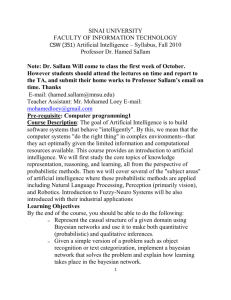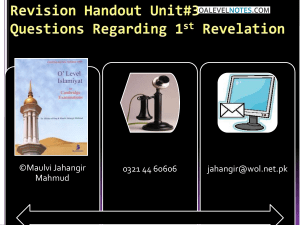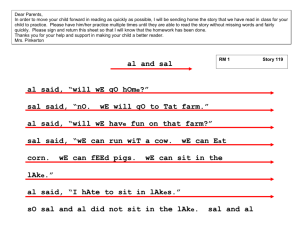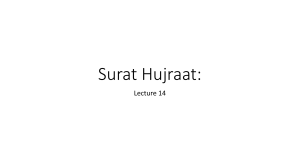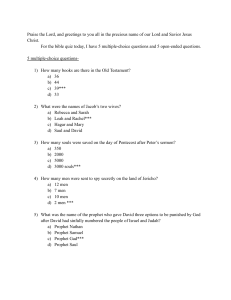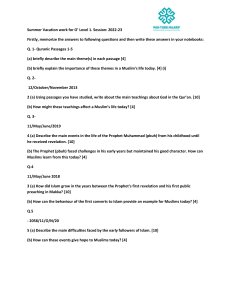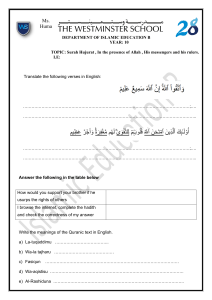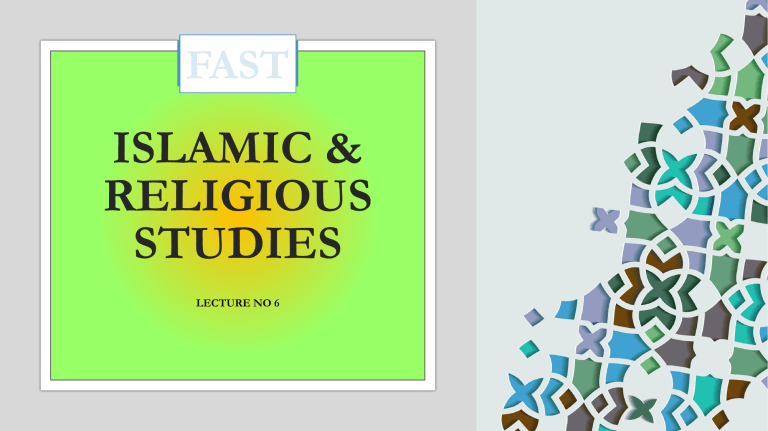
FAST ISLAMIC & RELIGIOUS STUDIES LECTURE NO 6 FAST BIOGRAPHY OF THE PROPHET ﷺ In Surah Al-Ahzab, it appears: • “There has certainly been for you in the Messenger of Allah an excellent pattern for anyone whose hope is in Allah and the Last Day and [who] remembers Allah often.” (33: 21) What is Seerah • It is an Arabic word whose linguistic meaning is: way or path. • The dictionary defines Seerah as conduct, manner, the way of life, attitude, behavior, history or biography. • Therefore, Seeratun Nabi means the way of the Prophet salAllahu ‘alayhi wa sallam. • It should be noted that the word can be used for anyone, for example, the Seerah of Abu Bakr radhiAllahu ‘anhu but since it is so commonly used for the Prophet salAllahu ‘alayhi wa sallam that now whenever someone hears the word ‘Seerah’ they attach it to the life of the Prophet salAllahu ‘alayhi wa sallam. IMPORTANCE OF SEERAH • The life of Prophet Muhammad is not to be learned only as his example as an individual. • His life is of importance to us also for the examples it presents in institutional development and in the progress of Muslim societies in aspects of law, the economy, social and political arenas, international relations, and in times of war and peace. • The Seerah covers the period during which the revelation continued. • A Muslim who examines the moral character of Prophet Muhammad not only needs to take into account all these matters, they should also have good and correct intentions The Importance and Benefits of Studying Seerah • the Prophet(Sal Allahu Alayhi Wa Sallam)’s character is an excellent example for us to follow, and we can learn this example by studying the seerah. • Muhammad (Sal Allahu Alayhi Wa Sallam) was a perfect model as a human being in each and every aspect of his life. • He was a political leader, military leader, an imam, a father, and a husband. And there is no example better than his to be successful in any of these positions. • His personality and character are like that of no other person and the best example for us to follow. Whose life is better to learn from than to learn from the life of the best man to ever walk on the face of the earth, the Prophet (Sal Allahu Alayhi Wa Sallam). And there is no example better to follow than to follow the example of the man who Allah commands us to follow, the Messenger of Allah (Sal Allahu Alayhi Wa Sallam). Seerah increases our love for the Prophet • Studying Seerah is a sign for our love for the Prophet (Sal Allahu Alayhi Wa Sallam) as well. When you love somebody you would want to know as much as possible about that person. Similarly if you love the Prophet (Sal Allahu Alayhi Wa Sallam) there has to be an indication of your love for him (Sal Allahu Alayhi Wa Sallam). And one of the signs of a mu’min (believer) is their love for the Prophet (Sal Allahu Alayhi Wa Sallam). • If a person loves the Prophet (Sal Allahu Alayhi Wa Sallam) then he is a mu’min and when a person has no love for the Prophet (Sal Allahu Alayhi Wa Sallam) then he is not a mu’min. • If a person claims to love Mohammed (Sal Allahu Alayhi Wa Sallam) then there must be an interest in him or a reason as to why he loves the Prophet (Sal Allahu Alayhi Wa Sallam). There must have been something special in the Prophet (Sal Allahu Alayhi Wa Sallam) that makes a person love the Prophet (Sal Allahu Alayhi Wa Sallam) over everyone else. We learn those special things about the Prophet (Sal Allahu Alayhi Wa Sallam) in the Seerah. Seerah educates us about the meaning of the Qur’aan • Without the complete knowledge of the seerah we could not understand the Book of Allah (Subhanahu Wa Ta’ala). The Qur’aan in some ways depends on the seerah for its full explanation or meaning. It sheds light on why the verse was revealed and the context of the revelation. In order to get a full understanding of the Qur’aan we need to get a full understanding of the seerah as well. Studying the seerah raises our hopes and lifts our spirits • After studying the torture and turmoil that the companions and the Prophet (Sal Allahu Alayhi Wa Sallam) went through, it helps us during our times of troubles and turmoil. • It gives us hope that as long as we stay upon the truth there is always hope at the end. When we see that we’re not the first ones to be persecuted, we find an increase in our eeman and it raises our hopes for the future, especially in these times when the Muslims are being targeted and singled out and attacked in all kinds of ways. We get to see real life examples of what the people before us went through and the victory they achieved. • Studying the seerah is one of the greatest ways to increase our optimism for the future. It gives up hope that at the end of the road as long as we stay upon Islam there is something good. The Prophet (Sal Allahu Alayhi Wa Sallam) was also revealed stories of the past prophets to give him hope. An example of this is the revelation of Surat Yusuf to the Prophet (Sal Allahu Alayhi Wa Sallam) to show him that even though his own tribe is going against him, Yusuf (Alayhis Salaam)’s own brothers were inflicting harm upon him. Seerah raises our eeman • Allah (Subhaanahu Wa Ta’ala) reminds the Prophet (Sal Allahu Alayhi Wa Sallam) in the Qur’aan of the stories of the prophets of the past and you find that the Prophet (Sal Allahu Alayhi Wa Sallam)’s eeman increasing due to this. Allah (Subhaanahu Wa Ta’ala) says in the Qur’aan, • [And all we relate to you of the accounts of the messengers is to strengthen your heart therewith; and in this has come to you the truth and an admonition, and a reminder to the believers] • Surat Hud (11) Verse 120 • As we know that the eeman of the Prophet(Sal Allahu Alayhi Wa Sallam) was incomparable to that of anyone else. It was higher than anyone else even the prophets of the past and the stories of the previous prophets that came before the Prophet (Sal Allahu Alayhi Wa Sallam) raised the eeman of our Prophet (Sal Allahu Alayhi Wa Sallam), then what else could the story of our own Prophet (Sal Allahu Alayhi Wa Sallam) do for our own eeman except increase it. Would it not be befitting for us then, that we turn to the seerah of RasoolAllah(Sal Allahu Alayhi Wa Sallam) to increase our own eeman? Timeline Of Rasulullah SAW before Revelation • Well of Zam Zam • Story of the Elephants • (Ababeel) Birds from Allah Timeline Of Rasulullah SAW before Revelation • Son of the two sacrifices • Death of Abdullah • Birth of Rasulullah SAW in April 571 • Miracles (Persia, Shaam) • He was named Muhammad Family Tree of Rasulullah SAW Muhammad Abdullah AbdulMutalib Hashim Abd e Munaf Qusai Kilab Mura Ka’ab Luwai Ghalib Fahar(Qureysh) Malik Nazar Kinana Khuzaima Mudrika Ilyas Muzar Nazzaar Ma’ad Adnan Timeline Of Rasulullah SAW before Revelation • Under the supervision of Halima Sadia till the age of 4 Timeline Of Rasulullah SAW before Revelation • Purification of heart (Shaqqussadar) at the age of 5 • Trip to Madina at the age of 6 and the demise of Amina Timeline Of Rasulullah SAW before Revelation • Under the supervision of Abdul Muttalib • Death of Abdul Muttalib at the age of 8 • Trip to shaam at the age of 12 • Meeting with Buhaira Timeline Of Rasulullah SAW before Revelation • Halful Fazul • As a sheapherd Timeline Of Rasulullah SAW before Revelation • Buisness journey for Khadija Binte Khuwaiylid • Extra ordinary profit gains and the evidences of Maysara the slave • The title of Sadiq and Ameen • Never commited a sin even in the dark age. • Marriage with Khadija at the age of 25 • Renovation of Kaaba and the Judgment of Rasulullah SAW. Timeline Of Rasulullah SAW before Revelation • Spending nights alone in the cave of Hira • Ummul Mumineen Khadija use to pack food for him The First Revelation • Liked to stay alone • True dreams • Cave of Hira • First revelation • Support from Khadija • Consultation with Warqa bin Nawfal The First Muslims • Khadija amongst the women • Ali amongst the children • Abubakar amongst the men • Zaid bin Harisa amongst the slaves Generally the belivers were not rich Preaching of Islam • Dare arqam was the meeting place of Muslims • Open preaching of Islam was not practiced • After 3 years Quran ordered for open dawah • At the mountain of safa • Lunch invitation at the house of Abu Talib Response of mushrikeen • Criticised Tawheed • Delagation came to Abu Talib 3 times • Internal meetings of Mushrikeen Clashes and Obstacles • Family Clashes • Status issue • Bad Traits • Their fake Gods Strategies by Enemies • Making fun • Propaganda • Competition • Deals • Lame questions • Took help from jews and Al Kahf • Spitting • Throwing Stones • Throwing Mud • Beating • Bullying • Throwing garbage Sacrifices of The Companians • Musa’ab bin Umair • Zubair • Bilal • Ammar bin Yasir and his family • Khubab • Zunaira • Sohaib Rumi Migration to Habsha in the Fifth year • 11 men and 5 ladies • From Rajab to Shawwal • Repenting due to rumors • 86 men and 16 ladies in 2nd hijrat • Quresh’s Strategy (2 Guys sent to habsha) • In front of Najashi • Amar bin AlAas vs Jaffer (R.A) Two big Entries Hamza bin Abdul Muttalib Umar bin Khattab Total Boycott in the seventh year • Seventh Year of Prophethood to the Tenth Year of Prophethood • The Mushrikeen had decided to put a total boycott on the tribes of Banu Hashim and Banu Abdul Muttalib (muslims and non-muslims.) The Muslims were forced out of Makkah into Sha'ib Abi Talib, they were reduced to eating leaves and roots. • Three Years Later the Boycott Ended Year of grief (AAM UL HUZUN) • Death of Abu Talib • Death of Ummul Mumineen Khadija 10 th year • Married Sauda Binte Zama • Married Ayesha Bint e Abu Bakr Dawah in Taif(120 miles away) • Importance of Taif(agricultural and educated area) • Elite of Makkah had their farm houses in taif • Reaction of 3 leaders(Abd e Yaleel, Masud, Habib) • Cheap tactics by people of Taif and request by Prophet. • Dua of Muhammad (saw) • Took shelter in trouble but dawah continued • Adas accepted Islam Dawah Continued in The tribes and Trade expos • Zu mijinna • Ukaz • Zu majaz • Hajj Miracles (Mujazat) • Spliting of the moon • Special gift of Isra And Miraj (Ascention to the Heavens) • Miracales are also tests to diffrentiate between the true belivers and the doubtful people Reaction of People of Makkah • They laughed , clapped and bullied • Asked questions about Bait ul Muqaddas • Asked about caravan and Habas e Shams • They called it Magic • Siddiq e Akbar Abu Bakr accepted and verified the incident as soon as he heard Rasulullah had said it The First Pledge of Aqabah In the Eleventh Year of Prophethood Six pilgrims had come from Yathrib, in Mina they met the Prophet (saw) and he called them to Islam; they accepted and promised that they would spread the message of Islam to their people and they would return the next year. The Next Year Five of the six people returned the next year with seven others. Here they had taken a pledge- it was known as the First Pledge of Aqabah The Second Pledge of Aqabah Many pilgrims came from Yathrib (Muslims and Pagans), in order to meet with the Prophet (saw) and to invite him to Yathrib. Seventy three Muslims went out to Aqabah including two women to make a covenant of their loyalty to the Prophet saw Migration to Medina • Muslims started to migrate to Medina seceretly • Ummar bin Khattab migrated openly in full view of mushrikeen • Mushrikeen of Makkah came togther in Darul Nadwa to stop muslims from migrating and establishing their own land. • They decided to kill Rasulullah SAW in a way every tribe gets involved in the crime. • Iblees also attended the meeting in the form of a tribe leader from Najd HIJRA • Finally Rasulullah got the permission to migrate to Medina • Kuffar failed in their attempt to kill Rasulullah SAW • Allah put dust in their eyes and they became blind • Rasulullah SAW left Ali behind to hand over the AMNATS Cave of Thawr • 3 nights in the cave • Snake bights abu bakar • Mushrikeen on the door steps of the cave • Peigion and the spider • Suraqa reaches the small caravan

